Norway has more electric cars per capita than any other nation. They have over half a million EVs, one for every 11 people. The combined capacity of all those rolling batteries is a whopping 34 gigawatt-hours.
That’s an average of 6 kilowatt-hours of storage per Norwegian, or 13 kilowatt-hours per household — a Tesla Powerwall worth of storage for every home. If they keep adding EV battery capacity at this rate, once road transport is 100% electric each household will average around 88 kilowatt-hours of energy storage on wheels.
Australia is following in Norway’s footsteps — or tyre tracks — and is starting to buy large numbers of electric vehicles. To help get us off fossil fuels, the Government should encourage EV purchases as a priority.
Ideally, any Australian EV incentives will favour cars that can provide grid-support via Vehicle to Home (V2H) and Vehicle to Grid (V2G) services. But even if EVs only ever act as a load, they will still be useful for grid management by storing surplus renewable energy generation.
Full EVs: 86% Of New Vehicles
In 2021 64.5% of new Norwegian car registrations were full EVs. For the first 3 months of this year, it was 82.9%. When plug-in hybrids are included, it rises to 91.1%. Conventional petrol and diesel vehicles were only 6.2% of registrations. The table below shows vehicles registered in 2022’s first quarter. I added translation notes from Norwegian in red:
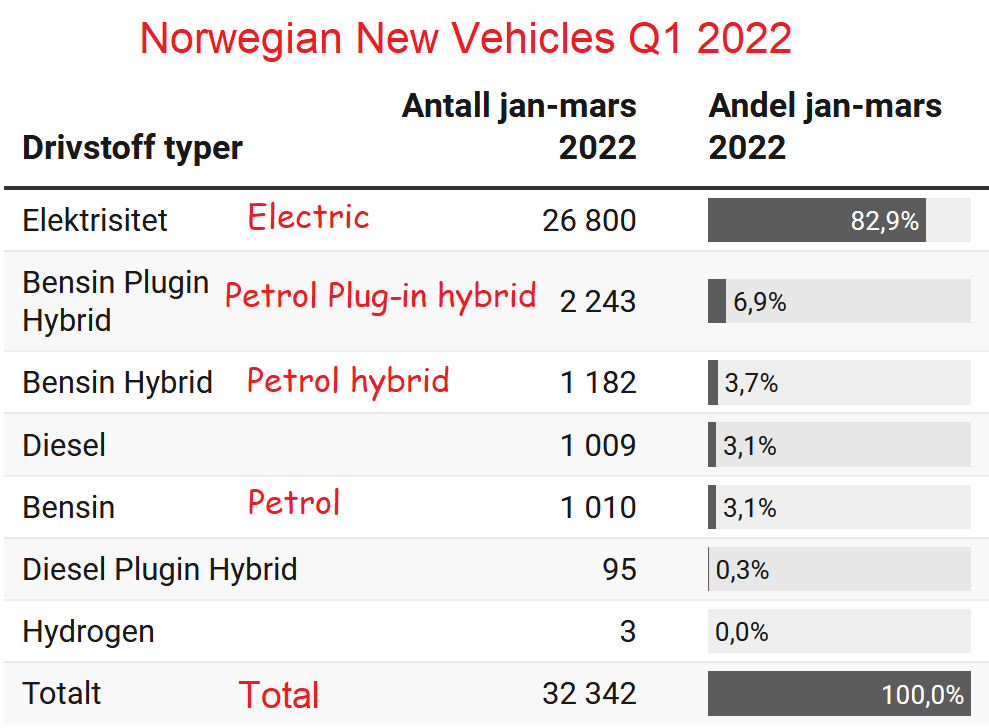
Damn Norwegians! I can forgive them for using words such as “Antall” for number and “Andel” for percentage, but using a comma instead of a decimal place is the devil’s work.
There are around 3.4 million road vehicles in Norway with 4 or more wheels. With over 500,000 full EVs, this means 15% are all-electric.
Hydrogen Cars Are No Go
Below I’ve shown how many hydrogen cars were sold in the first quarter compared to battery electric vehicles:
Battery electric vehicles outsold hydrogen vehicles by 8,933 to 1. Hydrogen cars are not taking off, and never will. Some people think hydrogen will be useful for heavy road transport, but I’m confident lower running costs will result in heavy trucks being battery electric.
Best Selling EV Models
Tesla produces the best selling EVs in Norway. The table below shows the top 10 best sellers in March this year:
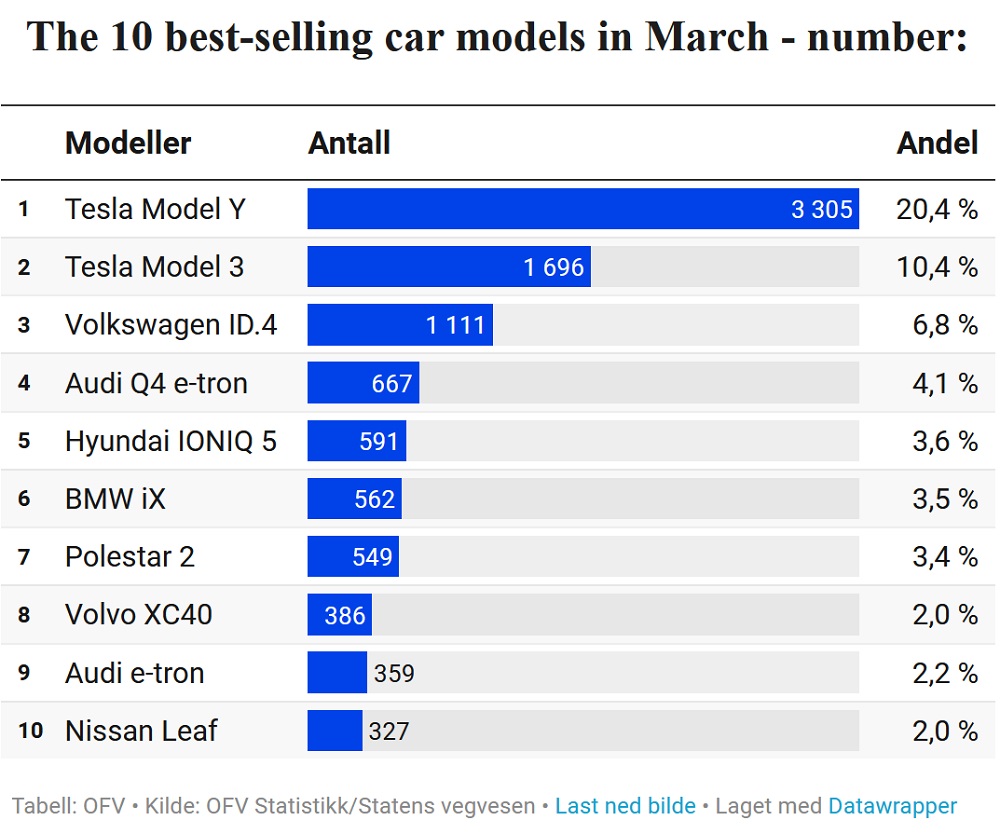
This information is taken from the Norwegian site called OF. This link should take you to a translated page.
Average Battery Pack Capacity
If I take battery pack sizes from the European EV Database and put them in the list of top 10 Norwegian EVs for March, I get the following:
This makes it clear Norwegians like to buy EVs with large battery packs1. If I assume for EV models with more than one battery pack size that two-thirds have the smallest while the rest have the largest, I get the following figures:
- Total battery capacity of top 10 electric vehicles sold in March = 648,000 kilowatt-hours
- Average new EV battery pack size in March = 68 kilowatt-hours
Once the battery packs of the few EVs outside the top 10 are added, it comes to more than 650,000 kilowatt-hours. Acquiring that much battery storage on wheels in a single month is an impressive achievement for a country with only 5.5 million people. It comes to 0.25 kilowatt-hours per Norwegian household. Note these aren’t Australian sized households with an average of 2.6 people. Norwegians, quite understandably, can’t stand each other, so their average household size is only 2.1 people.
If Norwegians continue at this rate, over 12 months they will add another 3 kilowatt-hours of EV battery storage per household.
On top of this, Norwegians are also getting a teeny bit of additional battery storage inside plug-in hybrids. I expect plug-in hybrid sales have peaked and before long new car sales will be almost 100% EV.
Total Battery Storage On ‘Wegian Wheels
If we assume the average Norwegian EV battery pack size is 68 kilowatt-hours and ignore the smaller ones in plug-in hybrids, then Norway has around 34,000,000 million kilowatt-hours of battery storage on wheels. That’s 34 gigawatt-hours. Averaged out, it comes to…
- 6.2 kilowatt-hours per Norwegian.
- 13 kilowatt-hours per household.
Assuming battery pack capacity continues to average 68 kilowatt-hours, once Norway goes from their current 15% EV penetration to 100%, their battery storage on wheels will be…
- 42 kilowatt-hours per person
- 88 kilowatt-hours per household.
To provide some comparison, a Tesla Powerwall 2 home battery system has 13.5 kilowatt-hours of usable battery storage when new.
EVs & Norwegian Grid Management
Norway doesn’t have a problem integrating new renewable generation into its grid because it is almost entirely renewable already. It appears to be 88% hydroelectric and 10% wind:
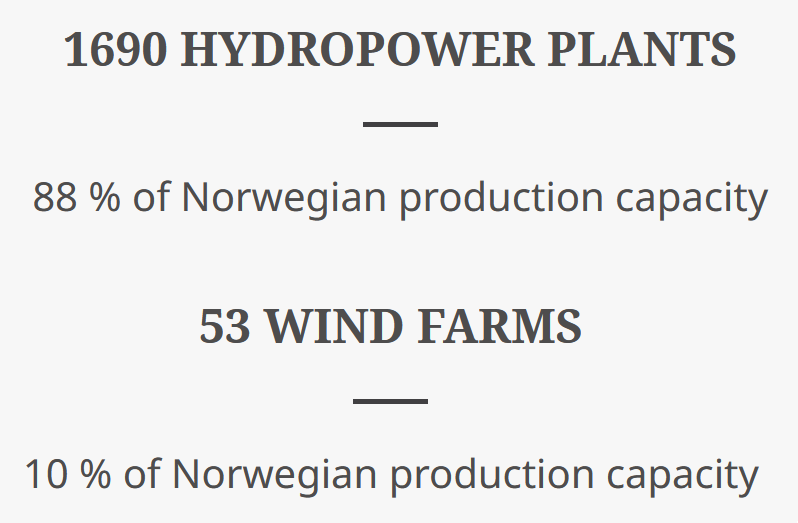
I tried to check whether “production capacity” meant production or capacity. My Norwegian is extremely limited, but as far as I can tell, the answer is “yes”.
Their massive number of hydroelectric dams can store enough energy to power their grid for over 8 months:
While Norway’s grid is almost as clean and green as it can get without sucking CO2 out of the air, almost every other country has a dirtier grid. Replacing internal combustion engine vehicles with EVs will make it easier for these nations to reduce fossil fuel generation.
Australian EVs & Grid Management
There are more than 20 million road vehicles in Australia with 4 or more wheels. If Australia had Norway’s 500,000 electric vehicles, that would only be 2.5% of the total. But even that would be useful for grid management. If you’re an EV owner, it’s plainly to your advantage to charge when it’s cheap, generally when all the solar is generating. You can use your own solar power system, or you can take advantage of everyone else’s solar panels by choosing an electricity plan with dirt-cheap daytime rates. There’s also no reason you can’t take advantage of both.
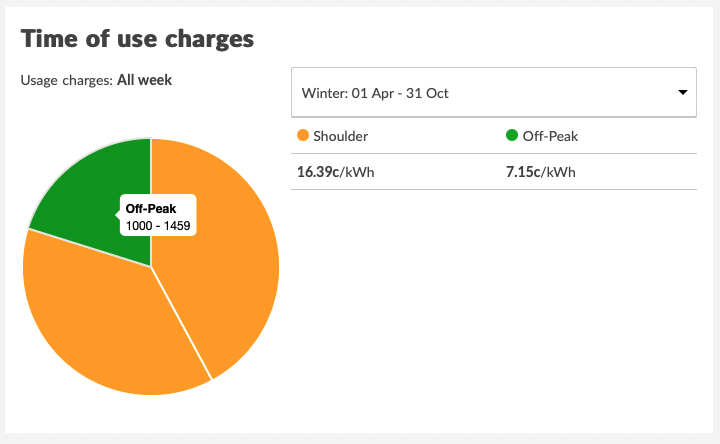
ReAmped’s Advance Time of Use Plus tariff in SA offers daytime electricity for just 7.15 cents per kWh
EVs will make wind and solar energy generation more profitable by increasing grid demand when renewable output is high. This will result in more new renewables driving fossil fuels out of the market2.
If half a million EVs were all plugged into 7kW car chargers, it would be technically possible to draw up to 3.5 gigawatts of power from the grid. That’s more than Australia’s largest power station can generate.
Obviously, people aren’t going to keep their electric vehicles plugged in all the time. They’ll want to drive them at some point. But they’ll prefer to charge them when it’s cheap.
V2G
Instead of just drawing power from the grid, electric vehicles can also push power back in one of 2 modes:
- V2H — Vehicle 2 Home: Your EV powers your home but does not export to the wider grid.
- V2G — Vehicle 2 Grid: Your EV exports power to the grid for anyone on the local grid to use.
Both of these are only being trialled in Australia3, but they have huge potential.
When Australia’s EV stock reaches 15% of all vehicles, like Norway has today, we’ll have 3 million electric vehicles on the road. If connected to bi-directional 7kW chargers, they could push up to 21 gigawatts into the grid. That’s enough to supply 2 kilowatts to every home in Australia and is more than the combined mid-afternoon power consumption of Queensland and NSW during a heatwave. Doubling the number of cars would let them supply more instantaneous power than the country has ever used.
Electric vehicles won’t have to provide power for long periods to be useful. Even if they only support the grid for a dozen hours a year, it would be enough to help prevent blackouts and provide grid stability. It will also result in very little battery deterioration because 7 kilowatts is nothing compared to the 200+ kilowatts the battery might have to punch out when you put your foot down driving up a hill.
Norway Is The Way
Which way should Australia go when it comes to EVs? I say Norway is the way. The advantages to our health, the environment, and the grid, are too huge to pass by. Fortunately, EVs have improved in quality and fallen in price, so we won’t have to offer the same level of incentives as Norway to transition to electric wheels.
A major reason electric vehicles have improved in price is due to demand from Norway, and there’s no way I’d let that pass without expressing my appreciation, so thank you Norway. We wondered who would be the first to electrify road transport? It turned out a Norwegian would.
Footnotes
- I like big batteries and cannot lie, You other ‘Wegians can’t deny, EV rolls in ready to race, Big battery pack in yo face… ↩
- Coal power stations can also benefit from EVs charging when prices are low but are hurt more by the increased renewable capacity. ↩
- But note there are EVs that will let you plug in an extension cord and run appliances off the battery pack. A feature that can be extremely handy in a blackout. ↩

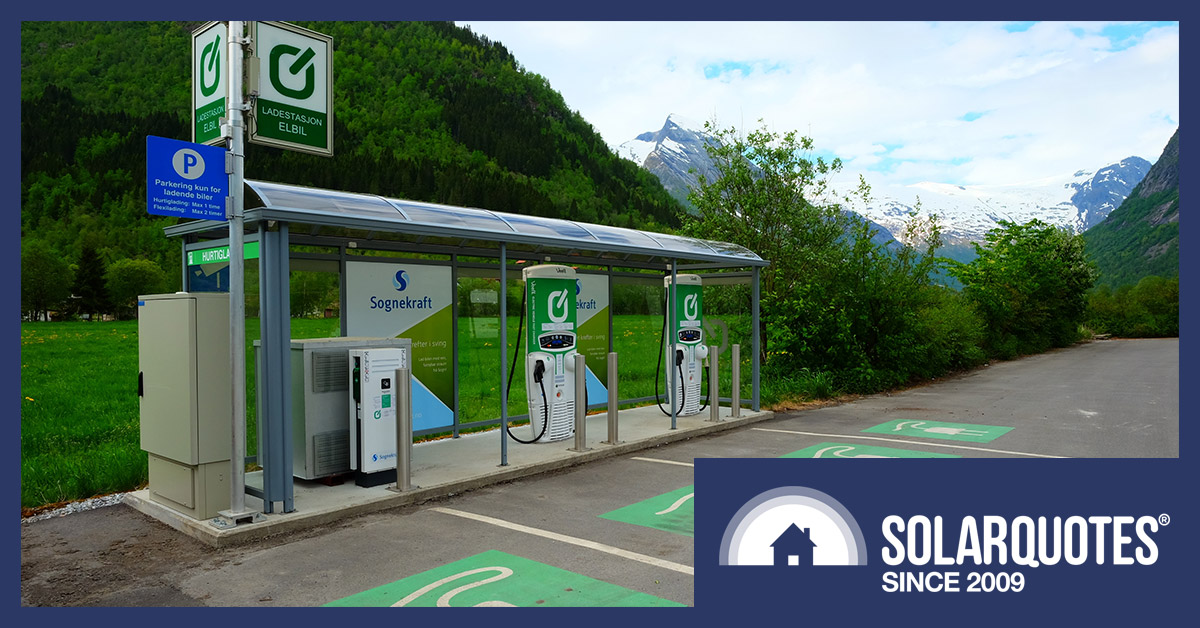

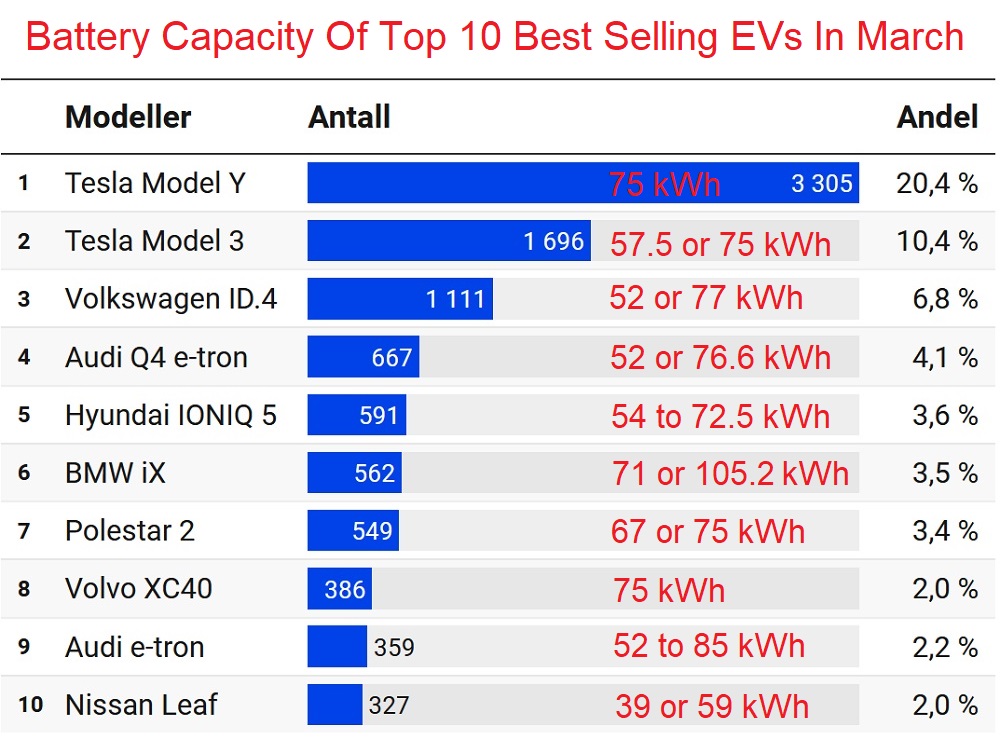
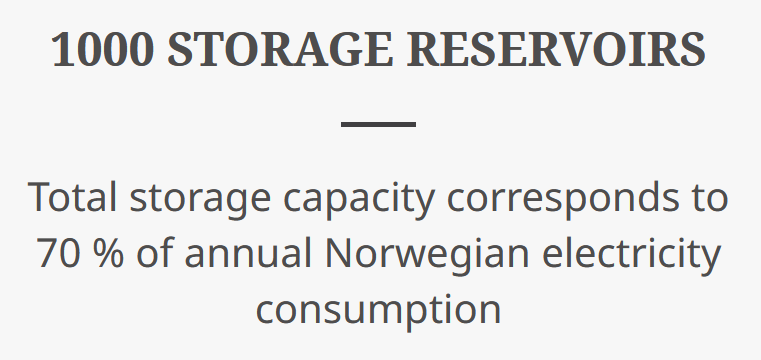
 RSS - Posts
RSS - Posts



Dcbel seems to be the leader in V2X?
https://www.dcbel.energy/
Dcbel seems to be the way of the future but it does not appear that the major solar inverter manufacturers have moved, as yet – guess they would argue that the vehicle manufacturers have not acted; except, in a minor way, Nissan and Mitsubishi.
Seems I can find that all vehicle sales in Norway are 70% ice vehicles not as you claim the other way round.
Why is that from official vehicle registrations
Narvik street cam:
https://www.skylinewebcams.com/en/webcam/norge/nordland/narvik/narvik-city-center.html
The vehicles with glass roofs are mostly Teslas.
Ronald,
“Australia is following in Norway’s footsteps — or tyre tracks — and is starting to buy large numbers of electric vehicles.”
I’d suggest the data indicates Australia is a very long way behind Norway; per the Electric Vehicle Council:
https://electricvehiclecouncil.com.au/ev-sales-boom-presents-chance-to-capture-serious-electric-benefits-if-government-acts-now/
Per ABS:
* There were 20.1 million registered motor vehicles as at 31 January 2021;
* 71.7% of the national fleet were petrol-powered vehicles;
* 26.4% of all registered vehicles were diesel-powered.
https://www.abs.gov.au/statistics/industry/tourism-and-transport/motor-vehicle-census-australia/latest-release#fuel-type
There are also unregistered vehicles that don’t venture onto public roads that are used for applications including in mining and agriculture.
Still a long way to go, but growth in EVs sale, from a small base, has been good lately, as I mentioned about a month ago:
https://www.solarquotes.com.au/blog/ev-uptake-sales-australia/
Hi Ron, EV’s are for sure much better than a fossil fuel burner but I’m still cynical, certainly when the manufacturers appear to be so preoccupied with glitz eg. accessories, or the shiny baubles as I prefer to call them, which is something that many of the tradie types have fallen for.
With Norway’s population of 5.5m and Hydro power production it should be possible to give the EV’s away. I do around 7000 klms each year in my Diesel van for business and cringe at the thought of humans driving for pleasure, as EV’s are usually portrayed in ads. I also have a dislike and distrust of people like Musk.
Anyway there is human immaturity and then there is technology, some of which might not ultimately be destructive, except there are 8b+ humans many of who’s main aim in life appears to be pleasure, fun, more fun and making more money.
As I said EV’s are better than fossil fuel burners, but better for the planet depends entirely on the intelligence of humans? Otherwise, more of the pearls before swine.
EVs are definitely better for the planet than a conventional car, even if charged from the grid in a coal heavy state such as Victoria. This is because they are considerably more efficient than internal combustion engine vehicles. As for distrusting Elon Musk, not trusting sales people is a good survival skill. I find I end up buying fewer bridges that way.
A bit off topic, but why don’t EV ‘filling’ stations not have any cover over them like a Petrol station has.? You know, to protect cuctomers from getting wet.
Surely you get wet when attaching the charge cable to the EV.
It’s only electricity, not like it’s flammable or anything.
Hydro power in Norway dates back to about 1892. Solar dates back to about 2008. Yes ‘renewable energy’ has a long history in Norway but conflating hydro with renewable is misleading. Perhaps it’s just me but when I hear folk advocating renewable energy they’re almost always talking solar and\or wind, not hydro, which is militantly opposed by the Greens.
While the piece does briefly acknowledge Norway offers incentives, it doesn’t specify the nature or degree of them. According to a late 2020 article here (http://webcache.googleusercontent.com/search?q=cache:9gxQAlM13toJ:https://www.theglobeandmail.com/business/commentary/article-norways-electric-car-subsidies-a-lot-of-money-for-not-a-lot-of-gain/&hl=en&gl=au&strip=1&vwsrc=0), there are billions in indirect subsidies. These include:
– Zero highway tolls for EVs (highly expensive usually)
– Removal of 25% VAT (GST) on new EV purchases
– Exemption from import duties
– Exemption from emission fees
– Zero fuel (road) taxes
– Cut-rate insurance
– Free or heavily discounted parking, road tolls, and car ferry tickets
Whereas a regular Volkswagon Golf costs about €36,600 the e-Golf only costs €25,300 and has negligible running costs due to government subsides.
Note too how the article mentions the local who pointed out that they still rely on 2 regular petrol cars for their local travel, and an EV for any ‘long’ distance driving e.g. the hour trip to the office.
In 2018 the annual subsidy was estimated to be about 5.8 billion kroner, or about AU$890 million. How much will the subsidy have risen to now?
Per Ronald’s screenshots the Tesla Model Y is the most popular, followed by the Tesla Model 3 (~30%). While it depends on the country as to which is most expensive, and there doesn’t seem to be Australian pricing for the Model Y, the Model 3 is still more than twice the price of the Toyota Corolla. Cutting GST would not change this significantly. Road tolls are usually inner city rather than inter-city and cutting these would simply exacerbate congestion. Obviously EVs don’t pay fuel\road taxes, but a high uptake would necessitate new taxes so as to ensure EVs pay their fair share for road usage. I believe Labor is proposing FBT savings for EVs, but this only helps the better off, especially the rich. Exactly how is Labor’s 90% of new sales be EV by 2030 supposed to work?
Ultimately the Norway-Australia comparison just breaks down. Norway is roughly 50% larger than Victoria – the second smallest state in the country, but has a slightly smaller population than said state. Half of this population however is found in an area roughly a third the size of Tasmania.
II guess you can argue both ways:
Case A: they are ‘subsidizing’ sale of EV’s
OR
Case B: they are penalizing the local rat-bags who are spoiling
the environment and thus indirectly ruining their tourist industry.
(It’s hard to ski on mountains that don’t have any snow on them. Cruises on oil slicked fiords wouldn’t be terribly popular either)
No doubt Norway is making a small fortune exporting their LNG into Europe at the moment too. They supply 20 – 25% of Europe’s gas.
Oil and gas together account for roughly 40% of the country’s total exports.
.
“These include:
– Zero highway tolls for EVs (highly expensive usually)
– Removal of 25% VAT (GST) on new EV purchases
– Exemption from import duties
– Exemption from emission fees
– Zero fuel (road) taxes
– Cut-rate insurance
– Free or heavily discounted parking, road tolls, and car ferry tickets”
Exactly what we need to quickly transition to EV’s in Australia. But instead we have no plan, no vision and no hope. I should add another incentive to the list.
Free charging during periods of excess solar generation ie between 10am & 2pm.
We need visionary leaders in this country not the dribble we see on TV energy day.
I think what I find most frustrating about all this is we are being sold a fallacy that EVs are “green” and we can all feel virtuous for having one.
What a load of tosh. Car manufacturers just want to sell more cars, they don’t care what sort. They are just cars and the cost an awful lot environmentally to produce and put on the road.
We can’t consume our way to being green.
Now swap your vehicle for active transport options and public transport options, supplemented with hire options as needed and that will have a material effect on reducing emissions.
These are the things we should be subsidising and spending taxpayers money on, not helping people buy more massively oversized 2 tonne metal boxes on wheels.
1. Driving an electric car does reduce emissions compared to driving a conventional car. If you are going to drive a car I’d prefer it to be electric than petrol or diesel.
2. There’s no need to subsidize electric cars. A tax on new vehicles based on their emissions is an incentive to buy EVs. It is greenhouse gas emissions that are the problem and the more directly they are targeted the easier the transition away from fossil fuel use is likely to be.
Jojo,
How would the Norwegian options significantly impact Australian purchasing of EVs?
– Highways don’t have tolls, congested city routes do
– GST is only 10%, not enough to significantly impact cost differences
– What are import duties, do they have significant impact?
– What emission fees? Some other tax?
– EVs use roads, shouldn’t they pay for the privilege?
– Cut rate insurance? Who pays? Remember EVs are a rare and very expensive product with limited support
– Are CO2 emissions or congestion the bigger issue? I’d suggest the latter.
Ultimately you’d see massive taxpayer support for the top end of society, the same end already able to transition. Labor wants 90% by 2030 as I recall, but there’s no logical path to it. How do those buying Corollas manage a Tesla 3?
Visionary leaders, sure, but where do we find them? If it’s not the Coalition, Greens, or Labor, it doesn’t really get any airtime or print space. Even if minor parties – Centre Alliance, One Nation, Values Party, whomever, come up with a brilliant vision, how do they get it out?
Des,
What spoiling of Norway’s tourist industry? If anything, Norway has too much snow, not too little. And I don’t recall hearing anything about oil slicks in their fiords.
George Kaplan,
“Ultimately the Norway-Australia comparison just breaks down. Norway is roughly 50% larger than Victoria – the second smallest state in the country, but has a slightly smaller population than said state.”
Per BP’s Statistical Review of World Energy-2021, from pages 18 & 22:
* Norway’s oil production in 2020 averaged 2,001,000 barrels per day (2.3% global share);
* Norway’s liquid fuel consumption in 2020 averaged 217,000 barrels per day (0.2% global share);
* Australia’s oil production in 2020 averaged 470,000 barrels per day (0.5% global share);
* Australia’s liquid fuel consumption in 2020 averaged 895,000 barrels per day (1.0% global share).
Norway is a net petroleum exporter, whereas Australia is a net petroleum importer.
I’d suggest Norway is preparing for the future, whereas Australia’s energy security situation is precarious and ill-prepared.
Well said. I was thinking most of what you wrote.
A further 2 cents… Those incentives offered by Norway are probably funded by its key source of wealth creation — liquid dinosaurs and prehistoric plants, pumped from the North Sea bed. Not so green after all, eh?
Yes, Norway is one of the greenest countries globally, and Norway should be applauded for this! Norway is the country with more Teslas per capita than any other country!
However, it would be remiss not to point out that the Norwegian government heavily subsidises the green transition, including heavily investing in EV prices by exporting oil and gas. Norway is one of the largest oil and gas exporters globally, so there is a bit of a contradiction there… Not mentioning this “dirty secret” in the above article was a shortcoming of the analysis.
More incentives?
I think not. I have been trying to buy an EV since September 2021. ( actually two cars)
Hyundai ioniq 5. Not 400 but only 270 arrive. I was one of the first deposits paid, only to be told sorry no… maybe August.
Kia put my name down heard nothing until I read ” all sold out for 2022.
BMW i4 put down deposit in October and signed contract. Initially promised JAN 22 find out in March DELAYS. I call and email for 3 weeks and get nothing but radio silence. I escalate to find out that no order has ever been placed on factory. Best that can now do is delivery Feb 2023. I can’t spend $120k knowing the service is this bad.
Mercedes has 9 month delay but no promises. Have me the very lowest trade in offer (on a 3yo Mercedes)
Tesla 12 months.+
Volvo 9 months ++
Polestar.. took my money said 12 weeks. Within minutes it was August. (25 weeks but that’s since slipped to September) With features removed so they can supply the US market. And get this. They have no service agents in any city. No mechanics in training. Those few who have had a car delivered had to pick it up from a disused warehouse or a pub carpark and then did all the fustrations and comms and software glitches DIY. One car was DOA on delivery so on this occasion they flew in the one tech from Sydney to get it moving. Too many tears for me so I cancelled.
All that is available is cheap finished cars …
I got all the incentive I need. Adding more hopefuls to the glacially slow purchasing is not a good idea.
So you’d contend that price and taxpayer subsidies aren’t the problem, the issue is EVs simply aren’t being shipped to Australia in more than hobby numbers?
While I am not a fan of the idea, what would it take for Australia to build a locally produced EV, something say akin to the Model 3 except with more range and less bells and whistles e.g. Model T type tech inside?
How exciting, so much battery storage and almost none of it able to drive any load beyond just the car, hence a worthless statistic.
Australia has not the money its ridiculous to make it happen 10 years the amount of emissions this country puts out is virtually is nothing where in a near trillion dollar debt we haven’t got money trees growing in Australia. We have China knocking on our back door arm Australia first step away for the time being and take it over 60 years .and get a company or companies up and going in Australia manufacture, to build electric components stations right here in Australia instead of relying on other countries it’s not rocket science.
Australians spend an average of $41,000 when they buy a new conventional car, while EVs have much lower fuel and maintenance costs. This means we can come out ahead by switching to electric cars in a large way now. If you are in the market for a new car, try one out. You may be impressed with their performance and how much you save on running costs.
Wayne hill,
“…the amount of emissions this country puts out is virtually is nothing…”
Australia is a major fossil fuels producer in absolute terms. What Australia does for GHG contributions matters on a global scale. See my comments at: https://www.solarquotes.com.au/blog/energy-emissions-iea-mb2386/#comment-1397398
“…its ridiculous to make it happen 10 years…”
We/humanity need to make it happen, or bear the consequences of civilisation collapse within this century.
As a consequence of the world continuing with its current policy settings regarding greenhouse gas emissions, global mean warming is likely to reach 3 to 4 °C above the pre-industrial epoch by 2100.
+2 °C means 99% of the world’s coral reefs, including the Great Barrier Reef, are eliminated. Sydney and Melbourne experience summer temperatures of 50+ °C.
+3 °C means the northern third of Australia could become unliveable.
+4 °C means civilisation collapse.
https://www.solarquotes.com.au/blog/energy-emissions-iea-mb2386/#comment-1397256
Climate scientist Andy Pitman says net zero needs to be reached by 2035 to have any chance of capping global warming at +2 °C relative to pre-industrial epoch.
https://reneweconomy.com.au/energy-insiders-podcast-2c-its-already-nearly-too-late/
The Laws of Physics are not negotiable.
Climate destabilisation is the unspoken matter, we have massive amounts of solid methane on the ocean floors. Small temperature changes can cause massive, run away gassing off.
In Australia we can not migrate to the cooler latitudes of the Great Southern Ocean. We are in the same sunny latitudes as the Sahara Desert, but we have a stable political government, great for investment.
With EV batteries the daily drive is only 7kwh. A 33kwh rooftop solar power system can easily top it up daily. Rush hour is only part of 24 hours, the rest of the time the EV car can be connected to the grid and making money trading power and stability.
THE MONEY WILL BE IN THE GRID.
Every building in the country is connected to the grid, every rooftop PV can be connected to the grid.
Petroleum will be the strategic military reserve asset in storage.
Ford killed the horse and cart thinking, the EV will kill the old power plant thinking.
Because it’s battery can do the long trip when needed but the daily drive is just a tiny little amount off the top of a permanently full battery.
Rush hour is 200 working days a year. 23hours/7 days a week plug the car into the grid. ezy pezy.
Thank you everyone for allowing me to break your old paradigm.
The latest battery technology makes all this possible..